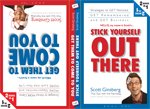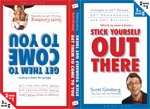 You can know the business.
You can know the business.
You can understand the people.
You can master the technology.
But if you’re not the world’s expert on yourself, succeeding as a young leader is going to feel like boxing an iceberg.
Today we’re going to explore seven personal and professional development strategies that most young leaders overlook:
1. Don’t be stopped by not knowing how. “But I’m not ready. I don’t know what I’m doing. And I don’t know the first thing about leading this organization.”
What’s your point? Who says you need to be ready? And who says you need to do know what you’re doing?
Leadership doesn’t necessarily require those things. In fact, if you’re a young leader and landed in your role unexpectedly, knowing how might not be an option right now. For now, here are a few pills of reassurance to swallow. One: You’re never ready. Nobody is. If they were, they would have taken action earlier.
Two: Knowing how is overrated. What matters is that you know why, and that you surround yourself with smarter, more experienced people who do know how.
Three: You’ll figure out how to do what you need to do along the way. Or, if you don’t, ask. Or, if you can’t, surrender to screwing up quickly and quietly – then learn your lesson and move on.
In the words of Selling Power CEO, Gerhard Gschwandtner, “We need to let go of the notion that we will ever get to any fixed point in our lifetime. The best thing we can hope for is to become more agile so we can avoid becoming a victim of change and become masters at successful transitions.” When was the last time you proceeded successfully without knowing how?
2. Build a galaxy of mentors. It’s impossible to meet the demands of your constituency if you’re not challenged and supported by your mentors. And not just one mentor – a galaxy of them.
First, casual mentors: You chat informally. You meet on an as-needed basis. You have lunches, hang out and take walks together. They talk; you listen. They share ideas; you write them down. They ask tricky questions; you spend months pondering the answers.
Second, formal mentors: You meet on a regular basis. You have structured discussions. You set goals, parameters and expectations for the relationship. They give you assignments; you return with homework. They expect a certain degree of commitment; you do what they say. They (sometimes) charge a fee; you gladly pay them for their wisdom.
Lastly, indirect mentors. You rarely meet in person. You learn by reading and gleaning. You might not even know each other. They write books; you read, highlight and learn. They do stuff really well; you watch, take notes and relate. They set the standard in your industry; you follow their lead.
Remember: One mentor isn’t enough. These are the different types of wise counsel you might consider keeping. Whose ship flies in your galaxy of mentors?
3. Submit to being stripped of your cynicism. During the months leading up to my induction as the president of a struggling organization, my friend Bill interrupted my stream of complaints and asked, “Have you always been this cynical?”
Ouch. Didn’t even realize I was coming off that way. But Bill was right: Cynicism was an outfit that didn’t look good on me. And his honest comment was precisely the kick in the pants I needed to strip myself of such negativity.
From that moment on, I promised myself that I would challenge the currents that create negativity or risk condemning myself to perpetual frustration. And now, instead of being cynical, I’m aggressively skeptical. Huge difference. Cynicism, in the words of Henry Rollins, is intellectual cowardice of not having to deal with what is.
Skepticism, on the other hand, is grounded in persistent objectivity and intelligent inquiry. Much better choice. Ultimately, people will notice – and be affected – the way you choose to shape your energy. Better watch what fumes you give off. When you walk into a room, how does it change?
4. Nothing is more followable than stunning clarity of purpose. It’s a surge of momentum in the right direction. That’s the consequence of conscious design. Like I mentioned before, knowing why trumps knowing how. The key is regularly asking yourself a series of purpose-oriented questions.
And while this doesn’t automatically pinpoint your purpose for you – it does create the conditions under which vision is most likely to occur. Then all you have to do is work backwards from that space of clarity. First ask, “If everybody did exactly what I said, what would the world look like?”
Second, ask, “Is what I’m doing right now giving people the tools they need to build that world? And third ask, “Am I teaching people how to use those tools profitably?
Do that, and your purpose will become following. As long as you remember one caveat: People buy into the visionary before the vision. Clarity of purpose is wasted if the person holding it isn’t likeable. What three things are you doing regularly that don’t serve or support your vision?
5. Fear is the prerequisite of bravery. Without fear, you wouldn’t be human. But, try to escape fear – and you’ll do nothing but inflame the agony. My suggestion is: Use it. Turn toward it. Accept fear’s bid, throw your shoulder into it and mold that fear into something beautiful. I discovered this in yoga class, specifically, Camel Pose.
This challenging, vulnerable, back-bending posture terrified me for years. So much so that I never even attempted it. I just defaulted to my mat without even giving it a chance. But one afternoon, my instructor challenged me. She said, “If you’re scared of this posture, that means your body needs it. Try redirecting your fear into a new course and see what happens.”
Eventually, I figured: All right. What the hell.
So I plunged backwards, hand in hand with the fear and achieved the full expression of the posture. First time ever. And the crazy part was: It wasn’t nearly as bad as I imagined. By the time the posture was over I was like, “That was it? That’s what I’ve been losing sleep over for two years?”
That’s what fear does to you: It fools you into believing that it’s as big as your ego says it is. But it’s not. Because your ego is a pathological liar. Kind of like that famous quotation by Roosevelt, which I happen to think, is wrong. Because as a young leader, the only thing you have to fear is the fear of fear itself.
Once you realize that, your capacity to succeed will skyrocket. As long as you remember: While flinching is totally human and perfectly in order, your people are looking at your face to see where the organization is going. So, if you do plan to crap your pants, just make sure nobody can see the skid marks. Are you willing to flinch in private?
6. You will rise to eminence through ambition, toil and blood. But it has to be your blood. Don’t expect to succeed as a leader if you plan to play pitch-perfect cover versions of the previous leader’s hit single.
Instead, throw your hat into the ring. Stop depending on time to bring change. Take control of the clock, roundhouse kick the doors of opportunity open and make something different happen.
That’s the approach I took in my professional association last year. As a new, young board, we were tired of waiting for permission (from people who didn’t even matter anyway) to try something completely new.
Eventually, I just got pissed off and said, “You know what? Screw it. Let’s just implement the radical change and see what happens. We have so little lose that it would be dumb (not) to shift our approach.”
To our delight – and to the delight of our members – it worked. Our new programming schedule and restructured meeting agenda blew everyone away. Even if that meant a few of us on the leadership team had to bleed. Hey, it’s not called the razor’s edge for nothing.
Ultimately, I learned that if you take strategic risks while still respecting organizational tradition, you don’t end up making stupid gambles. As long as you remember: There are no cover bands in the Rock and Roll Hall of Fame. Are you the echo or the origin?
REMEMBER: To know yourself is to lead yourself; and to lead yourself is to lead others.
LET ME ASK YA THIS…
Are you turning your ideas into money or into more ideas?
LET ME SUGGEST THIS…
For the list called, “62 Pieces of Advice Busy Executives Need to Know, but Don’t Have Time to Learn on Their Own,” send an email to me, and you win the list for free!
* * * *
Scott Ginsberg
That Guy with the Nametag
Author, Speaker, Entrepreneur, Mentor
[email protected]
 Never the same speech twice.
Never the same speech twice.
Always about approachability.
Watch The Nametag Guy in action here!

 You don’t need more ideas.
You don’t need more ideas. “Motion organizes and creates order. It is by motion that all things tend to their equilibrium and find their place in the universe. And unrelenting motion is what helps conspire towards some unifying geometrical situation.”
“Motion organizes and creates order. It is by motion that all things tend to their equilibrium and find their place in the universe. And unrelenting motion is what helps conspire towards some unifying geometrical situation.” Six hours from now, I’ll be taking center stage here in Denver for the Optimist International Convention.
Six hours from now, I’ll be taking center stage here in Denver for the Optimist International Convention. The world’s FIRST two-in-one, flip-flop book!
The world’s FIRST two-in-one, flip-flop book! I’m aware of the irony of publishing a list of instructions on how not to conform.
I’m aware of the irony of publishing a list of instructions on how not to conform. Winning is for losers.
Winning is for losers. To execute is to put to death.
To execute is to put to death. If you’re not polarizing, you’re not monetizing.
If you’re not polarizing, you’re not monetizing. Execution isn’t a hobby.
Execution isn’t a hobby. The world’s FIRST two-in-one, flip-flop book!
The world’s FIRST two-in-one, flip-flop book! Finished is the new perfect.
Finished is the new perfect.